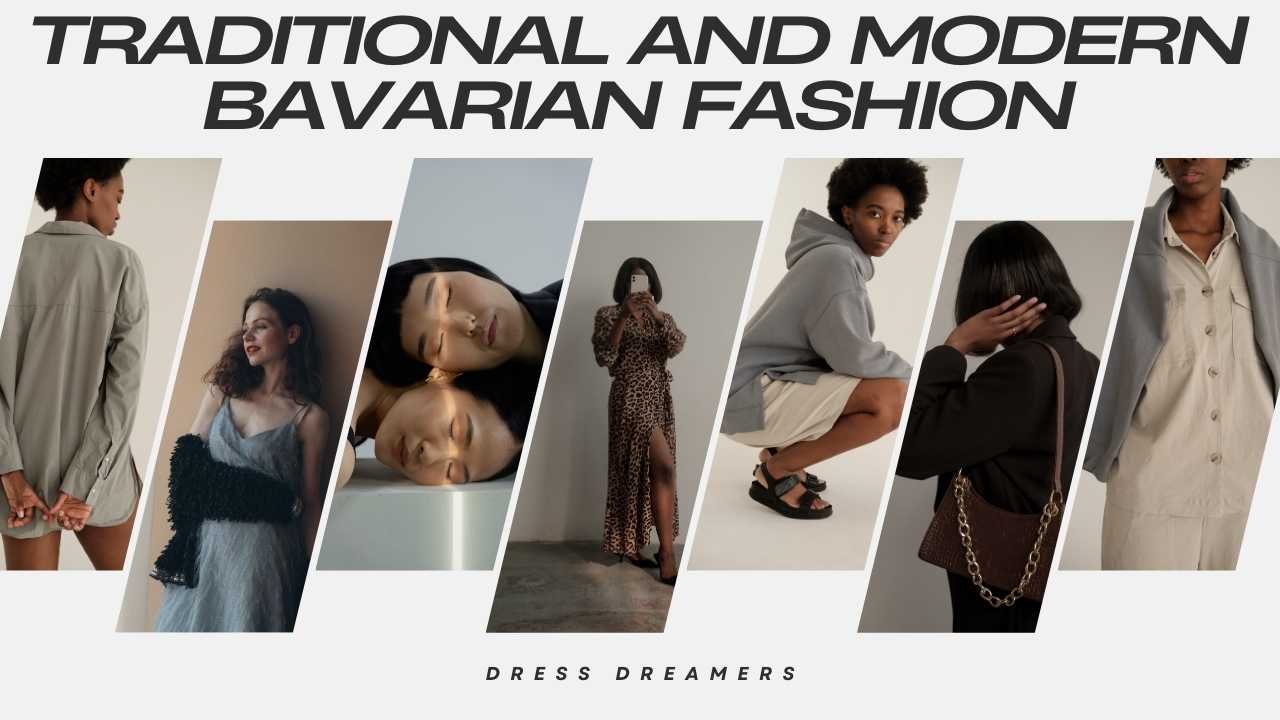Bavarian attire holds a deep historical and cultural significance. Over the years, it has evolved to incorporate modern elements while preserving its original charm. Exploring Traditional and Modern Bavarian Fashion, whether you’re preparing for Oktoberfest, attending a cultural event, or simply appreciating the craftsmanship behind Dirndls and Lederhosen, this guide will help you navigate traditional and contemporary styles.
The Essence of Authentic Oktoberfest Attire
Dressing in Bavarian fashion is more than just a style choice—it’s a way to honor age-old customs while making a statement at one of the world’s most festive celebrations.
| Timeless Traditions: Classic Elements of Bavarian Fashion | Contemporary Twists: Modern Adaptations in Style |
| Lederhosen Through the Ages: From Classic to Contemporary | Slim-fit Lederhosen in varied tones |
| Dirndl Evolution: Traditional Embroidery Meets Modern Trends | Pastel and floral prints |
| Accessories That Define Bavarian Elegance | Modern jewelry, hats, and bags |
| Sustainability in Bavarian Fashion: Eco-Friendly Trends | Sustainable fabrics |
“Fashion is a language that creates itself in clothes to interpret reality.” – Karl Lagerfeld
The Cultural Importance of Bavarian Clothing
For women, the Dirndl, and for men, the Lederhosen, serve as iconic symbols of Oktoberfest. These outfits reflect Bavarian heritage, foster a sense of unity, and enhance the festival’s authenticity. By wearing traditional clothing, attendees connect more deeply with the culture and enrich the festive experience.
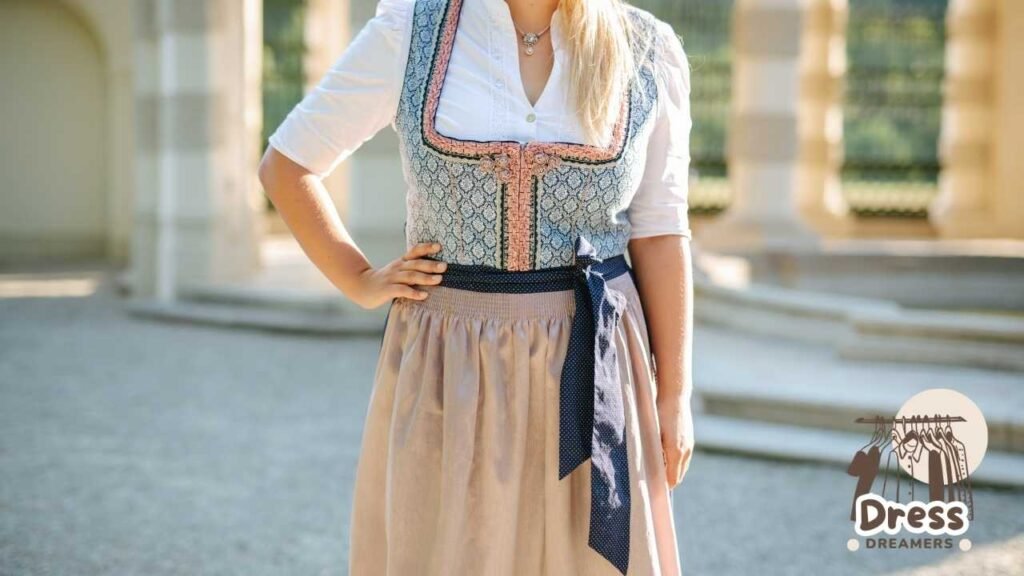
Oktoberfest and the Symbolism of Traditional Attire
Bavarian attire traces back to the 18th century, originally worn by peasants as everyday clothing. Over time, Dirndls and Lederhosen became emblems of Bavarian pride, worn at cultural gatherings and special occasions. Often made with fine materials and intricate embroidery, these garments showcase the region’s craftsmanship and history. Wearing them is a tribute to Bavarian heritage and its enduring traditions.
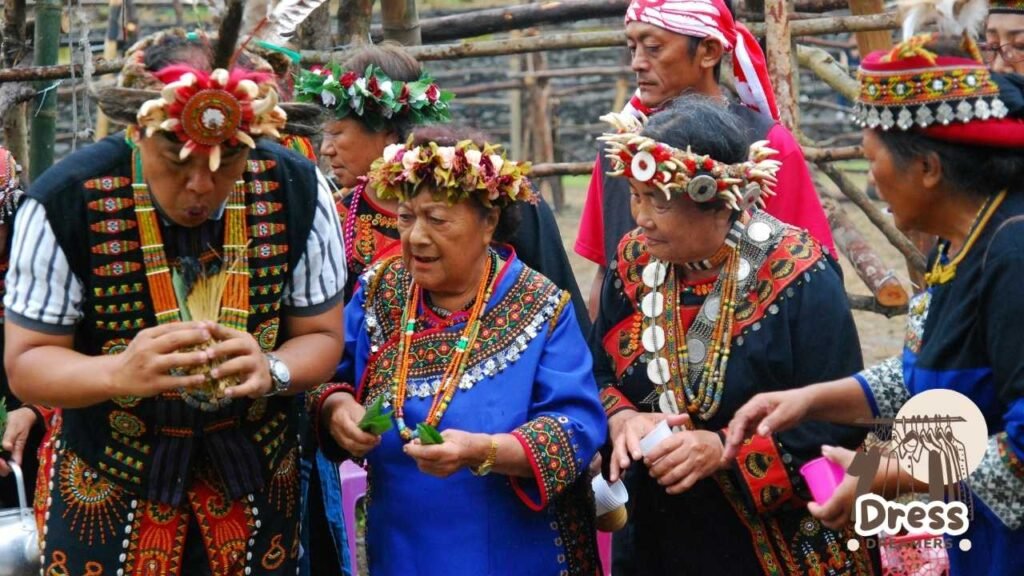
| A Journey Through History: The Origins of Dirndls and Lederhosen | The Evolution of Bavarian Fashion: From Peasant Wear to Cultural Pride |
| Lederhosen | Peasant workwear, 18th century |
| Dirndl | Domestic servant dresses |
| Accessories | Symbols of wealth & status |
Men’s Oktoberfest Fashion Guide
Dressing for Oktoberfest goes beyond donning Lederhosen—it’s about blending tradition with personal flair while respecting Bavarian customs.
Choosing the Right Lederhosen: Length, Fit, and Styling
Lederhosen, meaning “leather pants,” are available in three primary lengths: short, knee-length, and full-length. Short styles are favored by younger men, while knee-length versions suit various ages. Full-length Lederhosen, often paired with rustic boots, provide warmth and a more traditional look.
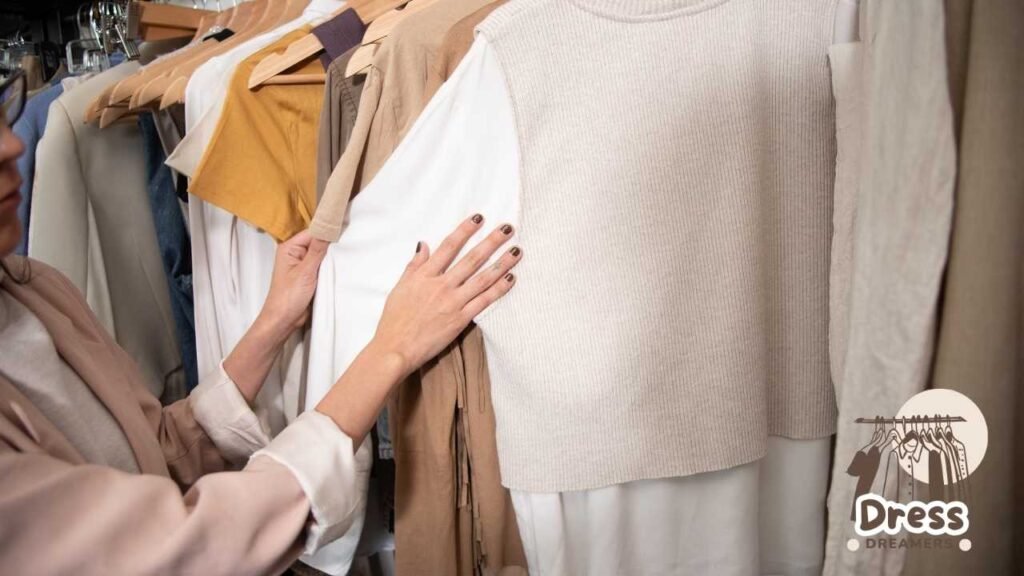
Key accessories include:
- Shirts: A checkered (red or blue) or classic white button-up complements Lederhosen perfectly.
- Shoes: Traditional Haferlschuhe, paired with wool socks or Loferl (calf warmers), complete the ensemble.
- Belts and Suspenders: Lederhosen may feature embroidered suspenders, while wide leather belts offer a slightly modern touch.
- Hats: A wool or felt Bavarian hat, often adorned with a feather, enhances authenticity.
- Additional Accessories: Pocket knives, decorative pins, and traditional hunting charms add character.
The Lederhosen Shop offers authentic German attire, providing complete outfits and accessories for Oktoberfest and other cultural events.
| Lederhosen Length | Best for |
| Short | Younger men, casual settings |
| Knee-length | Versatile, all ages |
| Full-length | Traditional, paired with boots |
Avoid These Common Mistakes When Dressing for Oktoberfest
- Opting for Fake Lederhosen: Choose genuine leather for authenticity and style.
- Incorrect Fit: Lederhosen should be snug but not restrictive.
- Overlooking Accessories: Details elevate the outfit, so don’t skip them.
- Wearing Inappropriate Footwear: Stick to traditional shoes instead of sneakers or flip-flops.
- Selecting the Wrong Shirt: A simple T-shirt or modern shirt can take away from the classic look.
- Overloading Accessories: Too many elements can make the outfit appear more like a costume than an authentic ensemble.
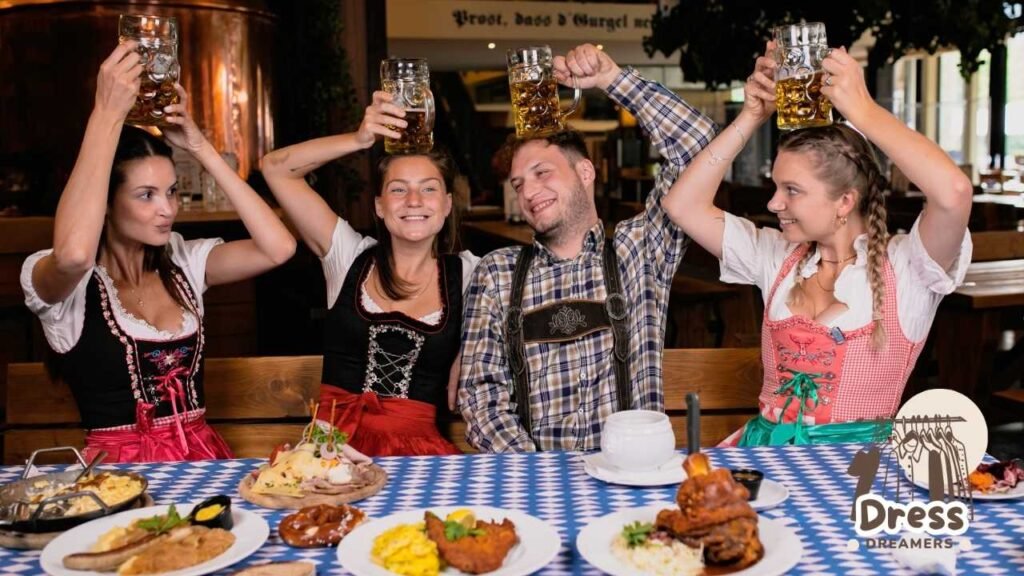
Women’s Oktoberfest Fashion Guide
A Dirndl is the essence of a woman’s Oktoberfest look, offering both elegance and versatility while respecting Bavarian tradition.
Apron Knot Etiquette: What Your Tie Placement Says
| Apron Position | Meaning |
| Right | Married or committed |
| Left | Single and available |
| Center | Youth or virginity |
| Back | Widow or server |
Dirndl Styles: Finding the Perfect Fit
Dirndls come in varying lengths:
- Short (above the knee)
- Midi (knee-length, the most popular for Oktoberfest)
- Long (ankle-length)
Key elements include:
- Blouse: Features puffed or lacy sleeves and a neckline—round, square, or heart-shaped—that suits your style.
- Bodice: Often adorned with embroidery, laces, or buttons to enhance charm.
- Skirt: Choose from vibrant colors, patterns, or traditional prints to complement your figure.
Apron Knot Etiquette
- Right: Married or in a committed relationship
- Left: Single and available
- Center: Traditionally signifies youth or virginity
- Back: Typically worn by widows or servers

Modern Dirndl Trends: Blending Tradition with Innovation
Contemporary Dirndls experiment with lighter fabrics, bold patterns, and unique colors, adding a modern twist while keeping tradition alive.
Popular accessories include:
- Jewelry: Chokers or necklaces featuring Bavarian motifs such as edelweiss flowers or hearts.
- Bags: Small handbags with Bavarian embroidery or rustic designs.
- Hats and Flower Crowns: Add a stylish touch to the overall look.
For footwear, consider closed-toe pumps, Mary Janes, or ankle boots. High heels may not be practical for long festival days.
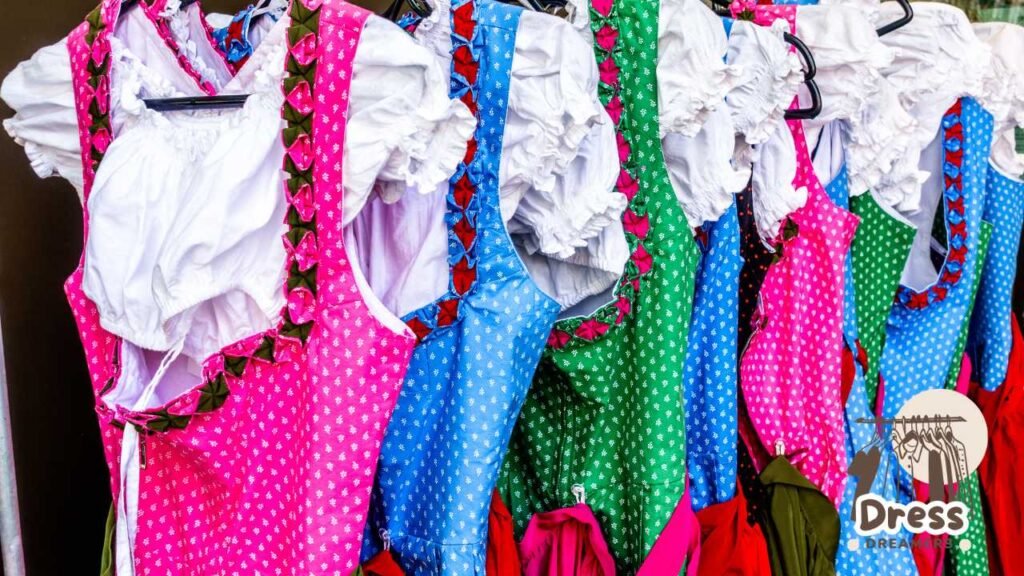
Merging Tradition with Modern Trends
Bavarian attire has evolved with modern influences, creating a fusion of timeless tradition and contemporary style. Designers are now incorporating:
- Dirndls: Soft pastels, floral prints, and asymmetrical cuts.
- Lederhosen: Unique leather tones like navy or forest green paired with slim-fit shirts.
Modern accessories also merge classic and trendy elements, allowing for personal expression while maintaining cultural respect.
The Future of Bavarian Fashion: Where Heritage Meets Innovation
When incorporating modern elements into Bavarian fashion, it’s crucial to preserve its authenticity by:
- Choosing well-crafted garments that reflect traditional workmanship.
- Keeping core design elements like embroidery and apron knots.
- Wearing modern styles in appropriate settings—traditional looks are best for cultural events.
- Balancing tradition and trends by pairing classic attire with subtle modern accessories.
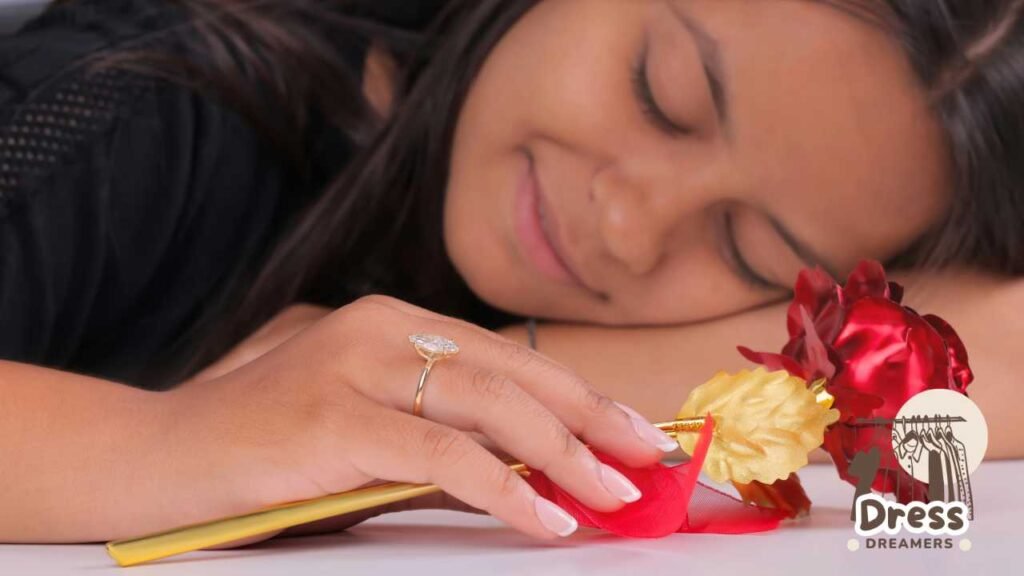
Alternative Outfit Ideas for a Comfortable Oktoberfest Experience
Not everyone wants to wear full traditional attire, and that’s completely acceptable! Casual options allow tourists to enjoy Oktoberfest while feeling comfortable.
Casual Yet Festive: Oktoberfest Attire for Tourists
For a relaxed yet respectful look, pair jeans with a checkered shirt. A neutral-toned hoodie or jacket adds warmth, while sneakers or boots provide comfort. Adding Bavarian-style accessories like a scarf, hat, or suspenders gives a nod to tradition.
| Outfit Idea | Description |
| Checkered Shirt + Jeans | A relaxed yet respectful look |
| Neutral-toned hoodie | Adds warmth while blending in |
| Sneakers/boots | Comfortable for long festival days |
The Finishing Touch: Accessorizing Your Oktoberfest Outfit
Hats
Bavarian hats, such as the Tirolerhut, often feature feathers or pins that symbolize local pride. Flower crowns offer a festive, feminine alternative.
Jewelry
Subtle accessories like edelweiss chokers or lapel pins enhance the outfit without overwhelming it.
Functional Bags
Small crossbody bags with embroidery or wooden accents keep essentials close without being cumbersome in crowded areas.
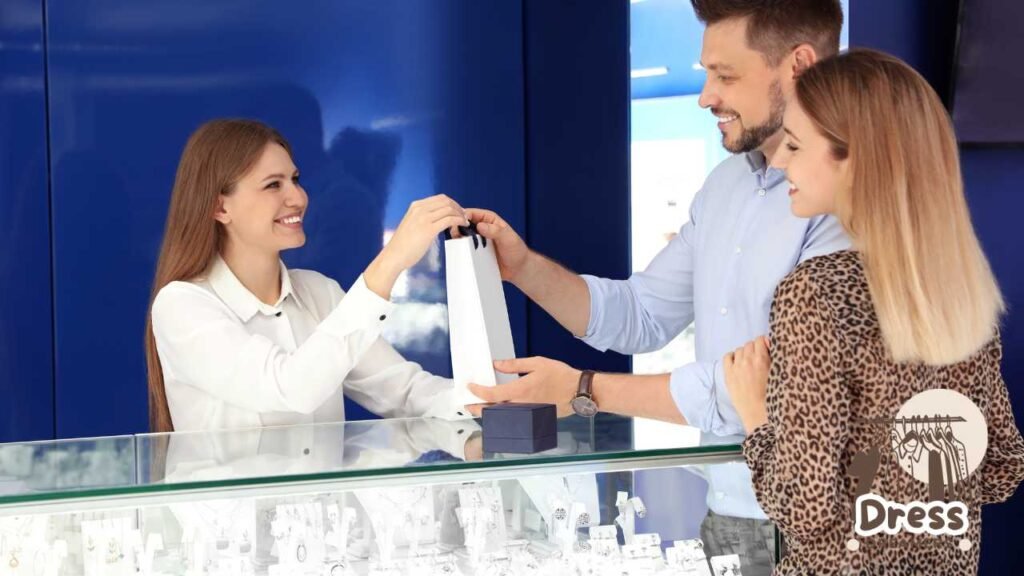
Answering Your Oktoberfest Fashion Questions
- “What should I wear?”
- Traditional attire (Dirndl for women, Lederhosen for men) is ideal.
- For casual alternatives, opt for plaid shirts and jeans.
- “What should I avoid?”
- Costumes that mock Bavarian culture.
- Oversized bags (often prohibited for security reasons).
- Unsuitable footwear like flip-flops.
Oktoberfest Do’s and Don’ts: Common Attire Mistakes to Avoid
- Wearing Fake or Poorly Made Attire: Invest in authentic clothing or choose thoughtful casual wear.
- Uncomfortable Shoes: Expect a lot of walking—wear practical footwear.
- Excessive Drinking: Pace yourself to keep the experience enjoyable.
- Ignoring Local Customs: Learning basic traditions like proper toasting etiquette (“Prost!”) enhances the experience.
- Arriving Without a Plan: Oktoberfest is bustling, so researching key tents and events is beneficial.
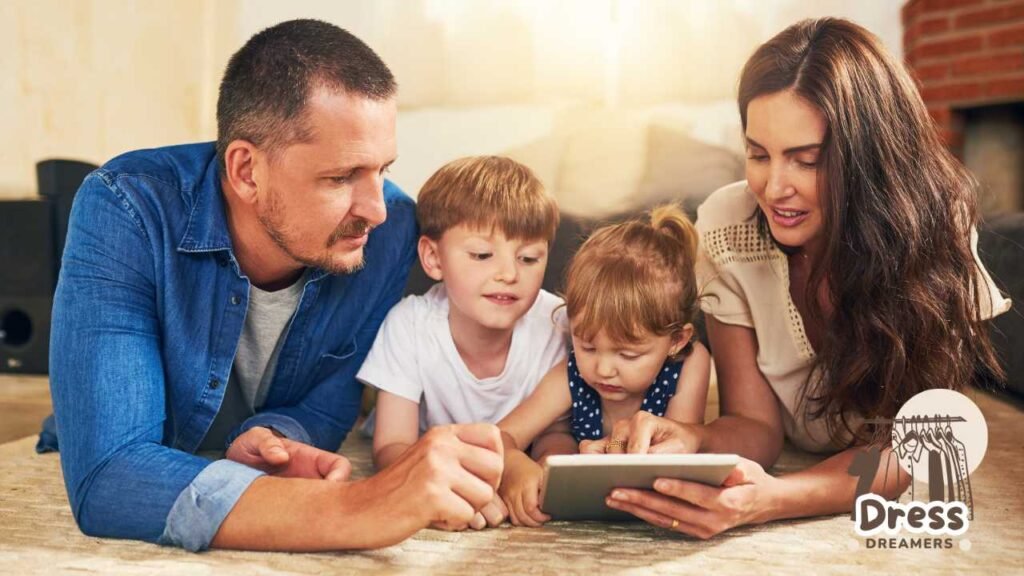
| Mistake | Alternative |
| Fake attire | Invest in authentic clothing |
| Uncomfortable shoes | Choose practical footwear |
| Excessive drinking | Pace yourself for enjoyment |
| Ignoring customs | Learn basic traditions like toasting etiquette |
More on Modern Adaptations – While you touch on modern variations of Dirndls and Lederhosen, you could add details about contemporary materials, sustainability trends in Bavarian fashion, or how high-end designers are redefining these outfits.
Regional Variations of Bavarian Attire – Different areas in Bavaria have unique twists on traditional clothing. Exploring regional differences in embroidery, fabrics, or styling could add depth.
Dressing for the Occasion: Choosing Bavarian Attire Beyond Oktoberfest – While Oktoberfest is the primary focus, Bavarian attire is also worn at weddings, folk festivals, and other cultural events. Including a guide on choosing the right Dirndl or Lederhosen for different occasions would be helpful.
Bavarian Fashion Beyond Oktoberfest: A Year-Round Cultural Statement – Traditional Bavarian clothing is deeply rooted in heritage and is worn year-round for various celebrations. A discussion on its importance in Bavarian identity beyond just Oktoberfest could enhance the article.
Frequently Asked Questions
What is the significance of Bavarian clothing at Oktoberfest?
Bavarian clothing honors centuries-old traditions, fostering cultural pride and authenticity at Oktoberfest. Wearing Dirndls and Lederhosen enhances the festive spirit and connects attendees with Bavarian heritage.
How do I choose the right Lederhosen for Oktoberfest?
Choose genuine leather Lederhosen that fits snugly but comfortably. Knee-length styles are the most versatile, and pairing them with traditional accessories ensures an authentic Bavarian look.
What does the position of the Dirndl apron knot mean?
Tying the apron knot on the right means taken, left means single, center signifies youth or virginity, and back indicates widowhood or being a server.
Can I wear modern accessories with traditional Bavarian outfits?
Yes, modern accessories like stylish jewelry, handbags, or hats can complement Bavarian attire. The key is balancing tradition with subtle, tasteful contemporary elements.
What footwear should I wear with Lederhosen?
Opt for Haferlschuhe, traditional Bavarian leather shoes, paired with wool socks or Loferl (calf warmers). Avoid sneakers or sandals, as they clash with the authentic Oktoberfest look.
Are there modern variations of the Dirndl?
Yes, contemporary Dirndls incorporate pastel colors, floral prints, and lightweight fabrics. High-end designers also experiment with asymmetrical cuts while maintaining the traditional silhouette and charm.
Can I attend Oktoberfest in casual clothing?
Yes, but it’s recommended to incorporate Bavarian elements. A checkered shirt with jeans and traditional accessories like suspenders or a Bavarian hat helps blend tradition with comfort.
How can I ensure my Bavarian outfit is authentic?
Buy from reputable retailers specializing in traditional attire. Look for high-quality materials, proper embroidery, and authentic designs to avoid mass-produced or costume-like imitations.
Are there sustainable options for Bavarian fashion?
Yes, many brands now offer eco-friendly Dirndls and Lederhosen made from sustainable fabrics like organic cotton, hemp, or ethically sourced leather, preserving tradition while reducing environmental impact.
Is Bavarian attire only for Oktoberfest?
No, Bavarian clothing is worn at weddings, folk festivals, and other cultural events. Different occasions may require varying styles, from formal embroidered outfits to simpler, everyday versions.
Conclusion
Bavarian fashion is a celebration of heritage, blending traditional elements with modern creativity. Whether you embrace a full Dirndl or Lederhosen or opt for a more casual approach, always respect the cultural roots while adding your personal flair. Prioritize comfort, accessorize thoughtfully, and immerse yourself in the Oktoberfest spirit. Prost to a stylish and meaningful celebration!
“Style is timeless. It has no season and no trend.” – Unknown
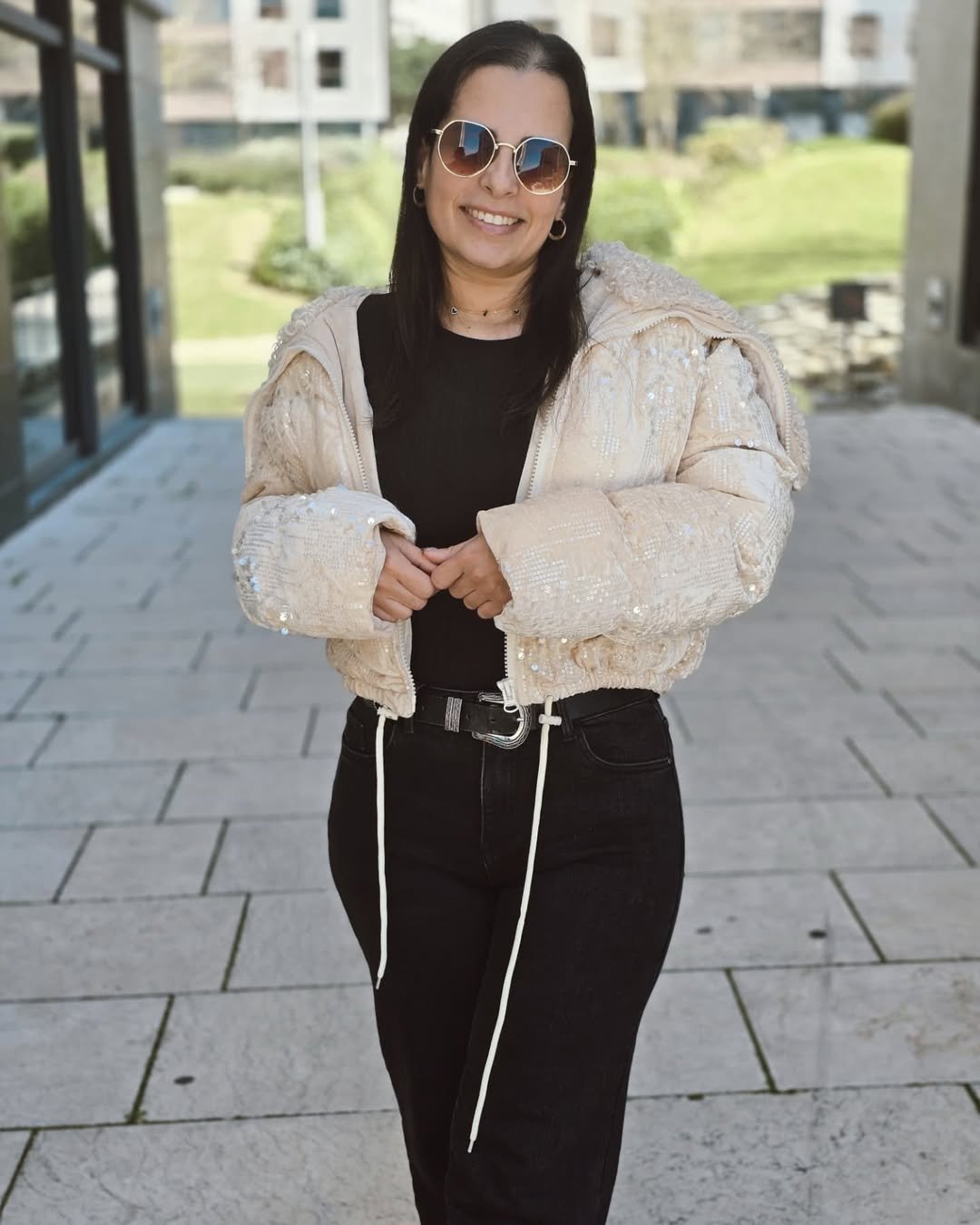
Catarina Ferreira – Fashion enthusiast and founder of Dress Dreamers. Based in Lisbon, Portugal, she shares insights on beauty, travel, fashion, and lifestyle. Passionate about inspiring others to express their unique style, Catarina curates trends, outfit ideas, and dressing guides to help you look and feel your best.

